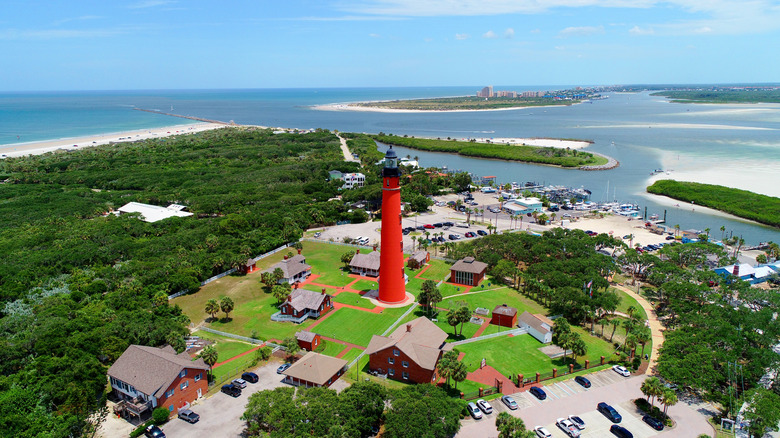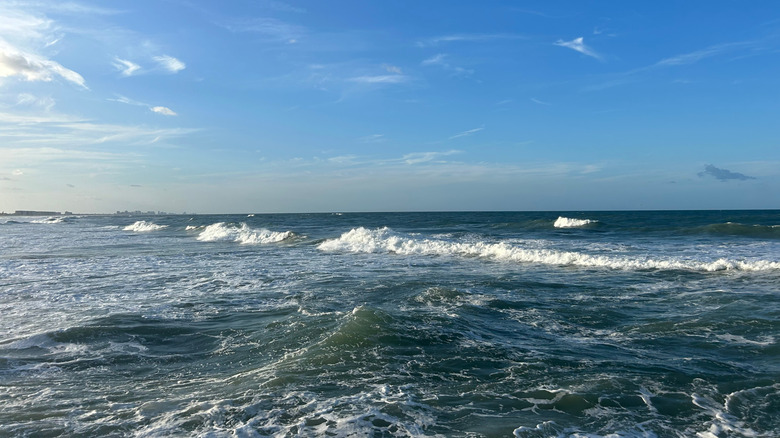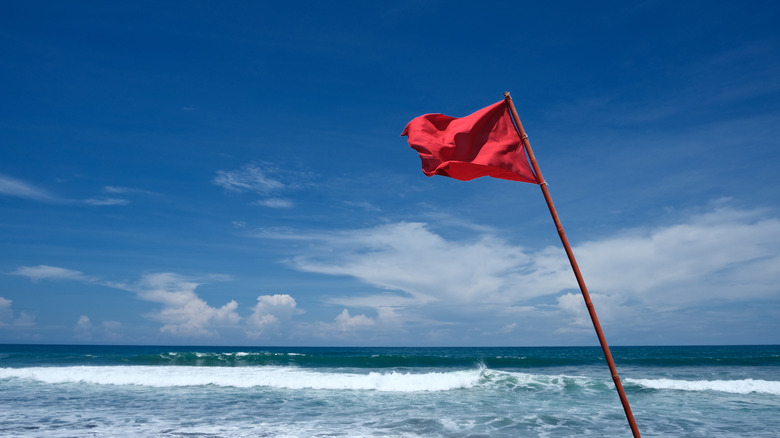Avoid This Quaint Florida Beach Near New Smyrna That Has Murky Waters And Deadly Rip Currents
With its terracotta-toned lighthouse and pure white sands stretching almost 4 miles, Ponce Inlet looks like an idyllic Floridian beach to relax and play in the waves. Yet, this stretch of coast just north of Smyrna Beach hides dangers in the waters, ranging from sharks to rip currents. In 2024, Simmrin Law ranked Ponce Inlet the 7th most treacherous beach in the United States (via Fox Weather).
Like other beaches in Volusia County, Ponce Inlet's rip current problem stems from wave movement over the area's unique ocean floor layout. "When we have bigger surf, those waves break on those sandbars, creating holes in the sandbar," explained deputy chief of Volusia County Beach Safety Ocean Rescue, A.J. Miller, to The Daytona Beach News-Journal. "And when that water is moving from the slough across the sandbar, it's going to take that path of least resistance, and as it cuts through that hole in that sandbar, it eventually creates a channel and almost a river flowing out to sea."
Other dangers arise from Ponce Inlet's murky waters. Unable to see the sand or determine the water's depth, swimmers and waders can easily lose their footing. In addition, particles in the water make it difficult to see sharks or other potential hazards.
Ponce Inlet is part of the Shark Bite Capital of the World
Lumped in with other beaches in Volusia County, such as New Smyrna Beach, Ponce Inlet bears the unfortunate title of "Shark Bite Capital of the World." Volusia County also includes this wildly popular Florida destination that's one of the deadliest beaches in America. Sharks bit humans 231 times between 1956 and 2008 in Volusia County, according to research conducted by the Florida Museum of Natural History. In particular, Ponce Inlet is considered a shark bite hotspot. In July 2024, a blacktip shark bit a teenager near a jetty in Ponce Inlet, while the same area reported two shark attacks over Labor Day weekend in 2023.
The frequency of shark bites in Ponce Inlet is due to several factors, including the sheer number of people splashing and moving in ways that interest sharks. "A human being of course, close to the surface, does a pretty good job looking like a seal, and one on a surfboard does an even better job," shared George Burgess, the director of the Florida Program for Shark Research, with LiveScience. And, with many people flocking to Ponce Inlet for the powerful waves, there are plenty of seal-shaped surfers in the water.
As the name implies, Ponce Inlet is where the Halifax River flows into the ocean. Marine predators like barracudas and sharks gather in this area of high tidal flow in search of their next meal. Although they're looking for bait fish and other marine critters, sometimes they bite humans.
How to stay safe at Ponce Inlet
First, always follow the directions of lifeguards on duty and make sure you understand what beach flag colors really mean. For instance, a red flag indicates the presence of high waves or dangerous surf. The lifeguards will raise a double red flag to close the beach quickly in case a shark is spotted in the water.
Don't enter murky water or swim and wade around a jetty in Ponce Inlet. Piers and jetties are dangerous spots to avoid swimming near while on a beach vacation because they attract sharks. As anglers tempt redfish and sheepshead in the waters, sharks are drawn in by the same creatures.
Most importantly, educate your family about what to do if caught in a rip current. In September 2025, Volusia County Beaches reported pulling 96 people from the water in a single day. Before heading to the beach, download the Volusia Beaches app on your phone. Here, you'll find up-to-date advisories and beach safety information.


